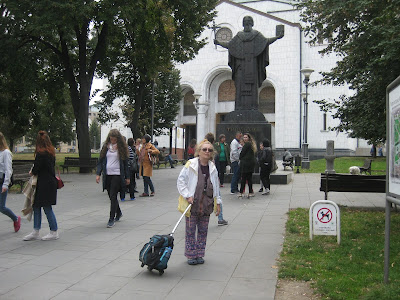In Belgrade, I visited both a famous orthodox church (St. Sava) and the only active synagogue in town (Sukkat Shalom). They say, during the WW2, the church was used by the Nazis as a parking lot, and the synagogue as a brothel.(OMG!).
The serbian St.Sava Temple, not far from the Slavija square mentioned in my previous post, merits all the high epithets available in the vocabulary: amazing, mind-blowing, stunning, spectacular, breath-taking...
Temple of Saint Sava
the main entrance area
It's big, and a work in progress ; the galeries on the first level are still under renovation process; the dome and downstairs crypt are already finished and provide the visitor with much wonder and excitement.Such richness of structure, vivid colors, fiery lights and fine materials (marble, granite, stone, crystal, gold)!
Such beauty of frescoes, murals, icons!
marble columns
gorgeous candelabre
superb arches and floor
people contemplating the paintings
My small, rudimentary digital camera cannot do justice to the sights inside and outside this gem.saints
After all ,science and religion are not the best of pals.
statue of Nicola Tesla in the church garden
During my brief stay in Belgrade, I got the impression that Nicola Tesla (1858-1943) is probably the most beloved and respected figure in Serbia. The airport is named after him, there's a museum (in the same area as the church) dedicated to his life and work as an inventor, researcher, engineer, physicist; there are monuments in the city honoring his memory, and more...museum Nicola Tesla
Compared to the 'St.Sava' church, 'Sukkat Shalom' (Dwelling of Peace ) synagogue is very modest . Still, nice building and yard, beautiful interior. On the day of my visit, people in the courtyard were disassembling the 'sukka' ( the hut-like structure in use during the jewish Sukkot holiday week).The synagogue building is not only a place of worship but also one of study and of community meetings, as it also houses the jewish community center with its various cultural and social activities.
approaching the gate
tiny yellow sign with the name of the synagogue
beautiful iron gate with David's shield in the middle
building's top with a David's shield, seen from the outside
exterior of the synagogue ( entrance covered by the trees)
prayer hall: upper balcony for women
'Aron Hakodesh' - Torah scrolls closet
Despite the fact that the synagogue and the little, well kept, very interesting jewish museum (placed on another street) are centrally located, I haven't spotted them easily as they are kind of integrated with the rest of the buildings in the row, with no visible signage. I've also felt slightly bitter about the security measures at the entrance. One can freely visit a church or a mosque, but not a synagogue or a jewish institution.
captive women (jewish museum)
Moses and the 10 commandements (jewish museum)
And yet, there was something that made my day. On the way to the synagogue there's a small eatery with a big sign Tel Aviv Hummus House. It's a popular place for those who love falafel, hummus, tahini and other middle eastern food. The visible yellow and blue sign , and the popularity of the place (open 24/7) are the best answer to terror threats and security measures.Tel - Aviv Hummus House






























































